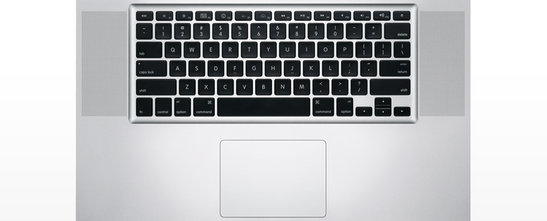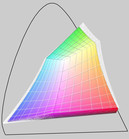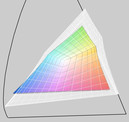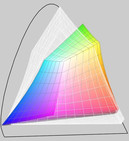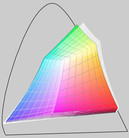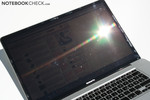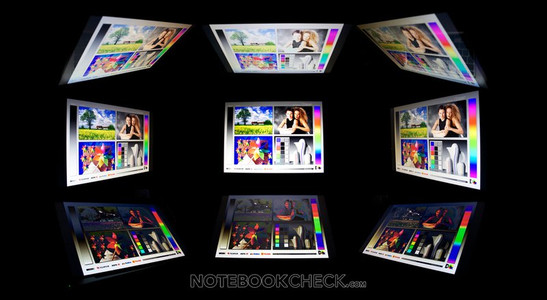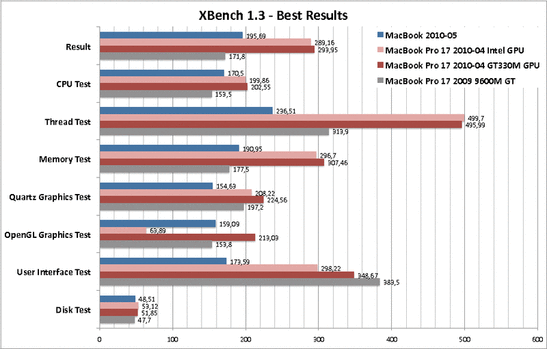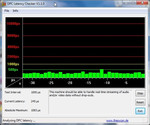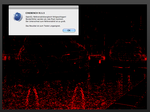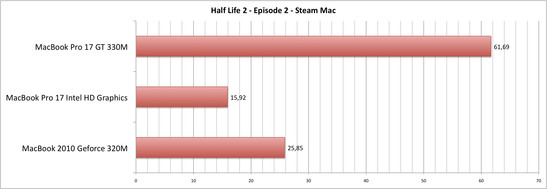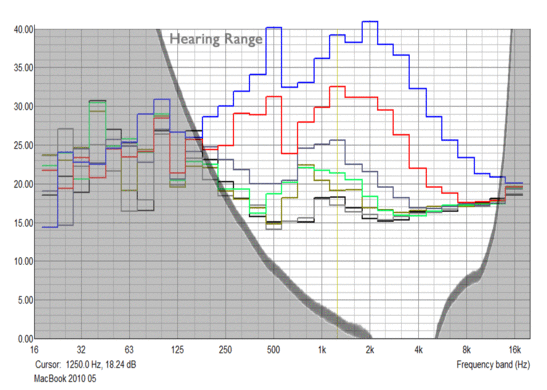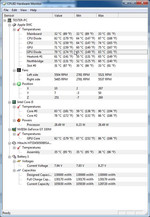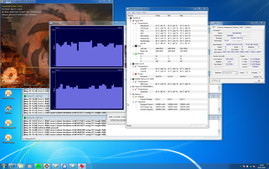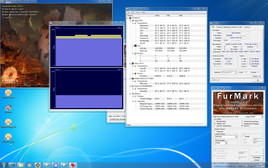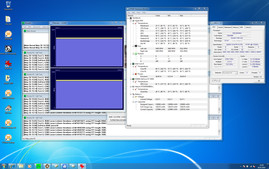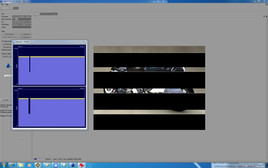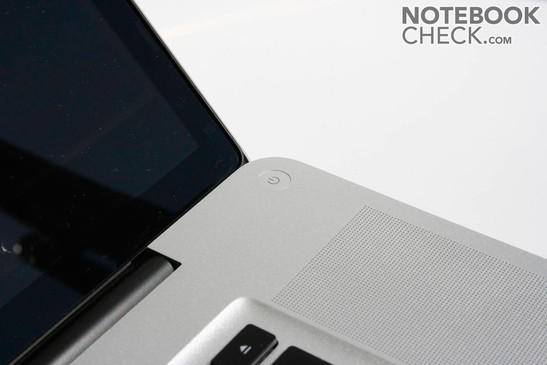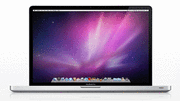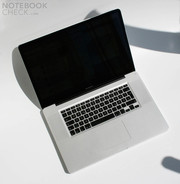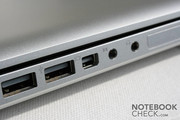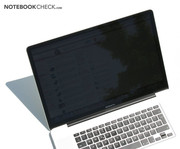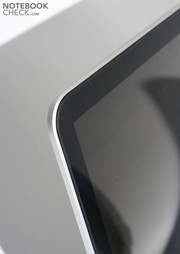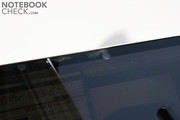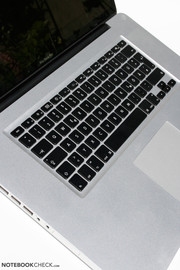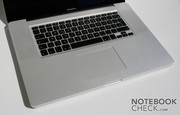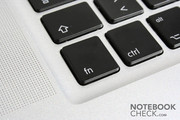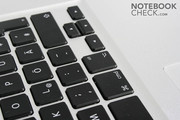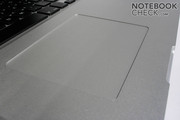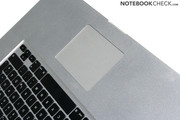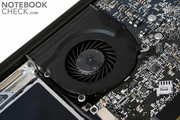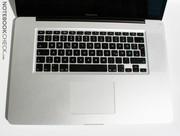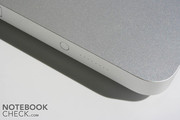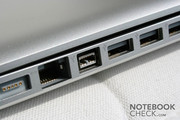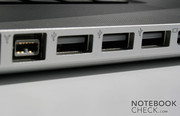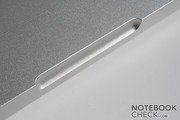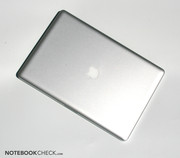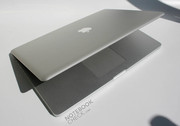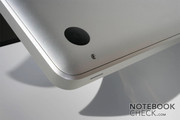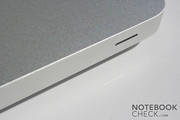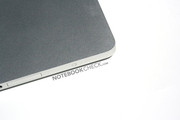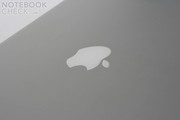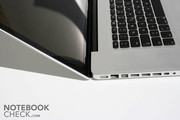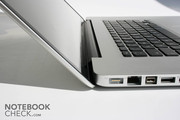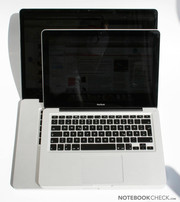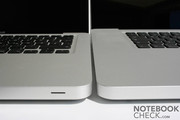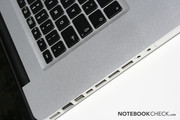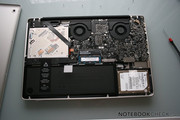Review Apple MacBook Pro 17 inch 2010-04 Notebook

The 17" Unibody MacBook Pro (MBP) is the top model of Apple's notebook series and, along with the 15" MBP, the strongest mobile notebook with Mac OS X. It remains to be the slimmest and lightest 17" computer of its performance category.
In addition to the standard configuration reviewed here, you can configure the Apple computer a bit more in the online store. Processors, memories, hard disks or SSDs and a matt display are found on the extra's list.
Case
The case of Apple's biggest notebook remains untouched in the new model. Thus, the following parts of the test are partly based on the review of the 17" Unibody MBP of 2009.
The unibody case is still milled from one single aluminum piece and pleases with its plain, timeless design. The design is practically identical to the smaller MacBook, or rather the 15" MacBook Pro models - just simply bigger. Still it doesn't look as attuned as the small MacBook's due to the large gaps between the keyboard and case's limits. Nevertheless, the 17" MacBook Pro is likely still the most beautiful 17" notebook on the market even after a year.
The aluminum case has virtually been manufactured without flaw. The gaps are Apple-typically even and the display lid also closes absolutely flush. Merely the base plate can be dented marginally with strong pressure.
The broad display hinge opens far enough, but is perhaps a bit to smooth.
The feel of the utilized materials is excellent. It is always fun to handle the notebook. Merely the fairly sharp front edge is a bit unpleasant at longer typing. The problem is kept within limits due to the case's low height, though.
Connectivity
Even the big 17" MacBook Pro is as stingy as its smaller colleagues in terms of wired interfaces. In opposition to its predecessor, the Mini DisplayPort now is able to transport sound and can therefore be turned into a full-fledged HDMI-out with an adapter.
Compared to the 15" model, the 17" MBP also has a further USB port and an ExpressCard34 on the case's left. In return, it lacks an SD cardreader. Nevertheless, the Mac doesn't look good in comparison to other 17" Windows' notebooks. eSATA, VGA, HDMI, cardreader, docking station and additional USB ports are found on the list of shortcomings.
The interfaces have all been placed on the case's left side, merely the Kensington lock slot is placed on the right. This is practical for righties and also acceptable for lefties because the placement is in the rear area.
The MacBook Pro bids the usual wireless interfaces for the price category. A speciality is the built-in draft-n WLAN chip from Broadcom (BCM4322) as usually Intel adapter are used in Windows laptops. The gigabit LAN is now also from Broadcom (BCM5701) (formerly in the 9400M chip set). Last but not least, there is also Bluetooth 2.0+EDR and a unidirectional infrared interface for the optional MacRemote remote.
The MacBook Pro 17 complies with the usual rules for software configuration of Macintosh computers. The newest Mac OS X operating system (10.6.3 Snow Leopard in this case) and the software suite, iLife 09 (iMovies, iPhoto, GarageBand, iWeb and iDVD) are supplied for daily tasks. Windows can be installed additionally via the Boot Camp assistant, as usual. But you'll need your own Windows version.
Input Devices
Keyboard
There haven't been any changes made in the single-key keyboard in comparison to the older model. The keyboard is identical to all other MacBook Pro notebooks and has the well-known layout from the Apple World. In comparison to the white MacBook, the stroke is a bit softer and the keys have a slightly superior quality feel. All in all the keyboard of the MBP17 is one of the best in all laptops we reviewed.
Touchpad
The glass touchpad (called trackpad by Apple) now has inertial scrolling in this latest refresh. This brings added momentum to your scrolling gestures, so to speak, which is particularly helpful when reading long webpages. The touchpad still has an excellent silky surface and no separate touchpad buttons. As before, it recognises a multitude of gestures using up to four fingers..
Windows' support for the touchpad is unfortunately not yet on par with the Mac OS X driver.
Display
The large 17" widescreen LED display lights up very bright with an average of 293 cd/m2 and is automatically dimmed by a brightness sensor. The illumination of 86% is still good for a display of this size and brightness. However, you can see two darker stripes reaching from the lower to the center display on a black background.
The fine resolution of 1920x1200 pixels results in a very large desktop and makes it possible to view FullHD videos without cropping. The good maximum contrast of 726:1 provides attractive colors.
| |||||||||||||||||||||||||
Brightness Distribution: 86 %
Center on Battery: 312 cd/m²
Contrast: 726:1 (Black: 0.43 cd/m²)
The 17" LED display's representable color gamut almost covers the sRGB color space and is thus comparable with the previous MBP 17's display. It is considerably larger than, for example, that of the white MacBook's standard display, but also a lot smaller than Dell's XPS 16's excellent RGB LED display.
You can still see something on the glossy display even in bright surroundings due to the excellent average brightness of 293 cd/m2. Nevertheless, the intense reflections are very taxing on the eyes so that a longer working time isn't to be recommended. Those who would like to use the MacBook Pro 17 often and for longer periods outdoors should definitely take the matte display alternative.
The viewing angles of the Samsung LTN170CT10 panel of our review sample are common for a TN screen - very good on the horizontal plane. Color deviations turn up relatively fast from above and below. The viewing angles have to be classified as good for its category, though.
Performance
The updated 17" MacBook Pro is now driven by a Core i5 or i7 processor with an integrated Intel HD Graphics graphic card and a dedicated GeForce GT330M with automatic switching.
The MacBook Pro 17 positions itself, as expected, in the same range as other notebooks with a Core i5-540M in the Windows processor benchmarks, Cinebench R10 and R11.5, wPrime and the CPU part of 3DMark06. This field is well in front of the Core 2 representatives due to hyperthreading and Turbo Boost. You can find the detailed results on the Core i5-540M's CPU site.
We measured the application performance under Windows 7 with 3DMark Vantage from Futuremark. The 17" MacBook Pro supplies a good result due to the fast Core i5 processor. However, the aluminum notebook ranks a bit below similarly strong Windows notebooks, in comparison. It achieves about the same result as the HP EliteBook 8440p-WJ681AW that is only equipped with a Core i5-520M and integrated graphic card, though. Notebooks with SSD hard disks can gain considerably. The Sony Vaio Z11 with a 128 GB SSD RAID is a whole 65% faster despite an equally clocked GT 330M and i5-520M.
In opposition, the upgrade can leave last year's MBP 17 with a C2D T9550 and GeForce 9600M GT considerably behind. Even the white MacBook with a Core 2 Duo P8600 and GeForce 320M is beaten by 41%. That should also apply to the 13" version. The faster Core i7 alternative should be about 6% faster (based on the MacBook Pro 15 with a Core i7 result).
| PCMark Vantage Result | 5749 points | |
Help | ||
The only well known system benchmark for Mac OS X is XBench in its latest version 1.3. Unfortunately, it fluctuates strongly from one run-through to the next, which is why we test every device about 5-10 times and only use the strongest run-through. The overall performance has improved considerably because of the fast Core i5. The drop in OpenGL Performance with the Intel graphic card can also be seen well. The improvements are outstanding in the thread test (thanks to hyperthreading in Core i5-520M) and memory test (because the memory controller is now in the CPU bundle).
The downclocked Nvidia GeForce GT 330M in the MBP17 reaches a noticeable performance boost compared to the old Geforce 9600M GT. It is 15% faster in 3DMark06, and also 15% in front of the 9600M GT in the old MBP in the 3DMark Vantage test. The power consumption is on a similar level due to the 40nm manufacturing.
GT330M graphic cards with a the reference clock rate (as in Samsung's NP-R780) achieve a 6-8% higher score in 3DMark06, and 15% more in the 3DMark Vantage GPU test.
The MBP 17's theoretical performance is overall significantly above that of the predecessor model, but not quite on the level that the GT330M would allow.
A feature of the new 17" MBP is the automatic graphics switching. However, it only works under Mac OS X and switches back to the Intel HD graphics implemented in the processor without graphic load.
The GT 330M can place itself clearly in front of the integrated Intel graphics in the graphic subtests of the highly fluctuating XBench 1.3. It's 3.3 times as fast in OpenGL, and even still 23% faster in the User Interface test.
We unfortunately couldn't execute a comparison between both graphic solutions in Cinebench R11.5. The OpenGL didn't provide any rates in the Intel HD Graphics due to a too great difference to the reference rendering (graphic errors, see screenshots with red pixels). In comparison to the white MacBook, the GT330M, with 15.08 points, can place itself in front of the GT 320M with 11.24 points.
Compared to XBench, the Intel HD Graphics, with 3454 points, doesn't lag quite as clearly behind the GT 330M (5140 points) in the Cinebench 10 Shading test. By the way, the old 9400M achieves almost the same rates as the GT 330M with 4000-4900 points. The 9600M GT reaches even a lot more with 5100-6200. That can only be explained by the different driver versions. Incidentally, the GeForce 320M in the new MacBook achieved 4465 points.
The built-in hard disk from Hitachi performsin the midrange of hard disks with a rotation speed of 5400 revolutions per minute with an average read rate of 62.4 MB/s. An advantage of the 500 GB HDD is its quiet operating noise. Because there is unfortunately only one HDD slot, you'll have to exchange the Hitachi HDD in order to upgrade, for example, to a faster SSD.
The downclocked GeForce GT 330M isn't necessarily a fast gaming graphic card. It is between a full-clocked GT 325M and GT 330M and beneath the Mobility Radeon HD 5650. Thus, demanding games are only playable smoothly in low details (e.g. Battlefield Bad Company 2). Older or less demanding games can, however, also be played smoothly in high details (e.g. Sims 3). In comparison to Windows 17" notebooks, usually equipped with graphic cards of performance category 1 in this price range, the performance is clearly poorer.
| 3DMark 06 Standard Score | 6032 points | |
| 3DMark Vantage P Result | 2356 points | |
Help | ||
| low | med. | high | ultra | |
|---|---|---|---|---|
| World of Warcraft (2005) | 208 | 157 | 42 | |
| Supreme Commander - FA Bench (2007) | 38.6 | 27.5 | 22.1 | |
| Call of Duty 4 - Modern Warfare (2007) | 189 | 60 | 35 | |
| Colin McRae: DIRT 2 (2009) | 98.4 | 42 | ||
| Resident Evil 5 (2009) | 83.1 | 31.7 | 17.9 | |
| Battlefield: Bad Company 2 (2010) | 52 | 28 | 20 | 11 |
| Metro 2033 (2010) | 33 | 23 | 10 |
The GeForce GT 330M can clearly pick up the victory cup for the fastest notebook graphic cards in MacBooks under Mac OS X due to lack of opponents. The OpenGL performance is enough to play Half Life 2 in high details in SXGA smoothly. The performance however is considerably better under Windows 7 and also allows playing in the display's native resolution.
Video Tests
As already the 15" version, the 17 inch MacBook Pro doesn't have any problems rendering HD movies. In case the graphic card support doesn't work (only few formats under Mac OS X), the processor is strong enough to render every video smoothly.
One innovation of the updated MacBook Pro 17 is the automatic graphic switching between the GeForce GT 330M and the integrated Intel HD Graphics graphic card. There is no flickering or latencies despite the utilization of multiplexers. Mac OS X however only allows two modes: Nvidia graphics always enabled or automatic switching. However, you can also switch manually with the Open Source tool gfxCardStatus. This even worked during Half Life 2 (from Intel to Nvidia) without flickering or problems in the test.
Normally, every 3D application is automatically switched to the GeForce 330M. The lack of possibility to switch manually to the GMA HD could also be due to the not yet perfectly adapted Intel OpenGL driver. If you set the Intel graphic card with gfxCardStatus, you'll notice a few graphic errors, e.g. in Half Life 2. Even Cinebench R11.5 aborts the OpenGL test because of the too great difference to the reference rendering (see screenshot).
The only application case that always has to run with GT 330M is the presentation of content on an external screen. The Mini DisplayPort is apparently directly connected to the GeForce GT 330M without multiplexers. But this is the case in many Optimus notebooks, too.
Emissions
System Noise
Both case fans in the area of the display rotate steplessly with 2000 - 5370 revolutions per minute depending on the load. They always remain in the lowest level without (high) load and are only discreetly audible in quiet surroundings at a distance of about 15 cm in quiet surroundings.
Running Mac OS X, the MacBook Pro stays relatively quiet even under load. The fans turned with 2700-4000 rpm (32-40 dB(A)) in Half Life 2 and disappeared discreetly behind the game's sounds.
The aluminum notebook reached its maximum volume under only in Windows 7. The fans are very audible with 5370 rpm and the measured 48.3 dB(A). The noise quality, however, remains pleasant (noise with quiet, higher frequencies).
Noise level
| Idle |
| 30.2 / 30.4 / 30.6 dB(A) |
| Load |
| 38 / 48.3 dB(A) |
 | ||
30 dB silent 40 dB(A) audible 50 dB(A) loud |
||
min: | ||
Temperature
The aluminum MacBook Pro's surface temperatures are always a topic for lively discussions. Apple knowingly uses the case as a cooling body to keep the fans' noises low. In some cases, the case temperature increases due to that, especially under Mac OS X, and the fans stay quiet.
The bottom actually never really stays cool, but there aren't any burns to be expected with a maximum of 42°C. The important wrist-rest always stays a lot cooler and is never unpleasant. Nevertheless, we would recommend the utilization of smcFanControl when used on the lap. You can turn up the fan speed manually with it. You can also achieve a low case temperature under load - obviously at the expense of system noise, though.
The internal temperatures after several hours of load with Furmark and Prime 95 stay within limits. Neither short periods of maximum (CPU 90°C, GPU 86°C) nor the low steadied temperatures (CPU 83°C, GPU 82°C) are alarming.
(±) The maximum temperature on the upper side is 45 °C / 113 F, compared to the average of 40.4 °C / 105 F, ranging from 21.2 to 68.8 °C for the class Gaming.
(±) The bottom heats up to a maximum of 42 °C / 108 F, compared to the average of 43.3 °C / 110 F
(±) In idle usage, the average temperature for the upper side is 35.1 °C / 95 F, compared to the device average of 33.9 °C / 93 F.
(+) The palmrests and touchpad are reaching skin temperature as a maximum (35 °C / 95 F) and are therefore not hot.
(-) The average temperature of the palmrest area of similar devices was 28.8 °C / 83.8 F (-6.2 °C / -11.2 F).
Loudspeakers
The loudspeaker system built into the aluminum case sound quite good for the low case height. It can't quite keep up with external loudspeakers, such as Logitech Lapdesk, but the given performance is fully sufficient for undemanding background music and for movies. The loudspeakers are also fairly loud with a maximum of 90 dB (distance: 15cm) (louder than those in the MacBook White).
The analog / optical audio outs are just as convincing with Sennheiser PXC 250 headphones in the test and provided a static-free, analog signal.
Battery Life
The new MacBook Pro 17 based on Core i5 could gain a bit in the idle runtimes (from a bit over 9 h in the predecessor to a bit over 11 h). This can be ascribed to the Core i5 with the integrated Intel HD Graphics, manufactured in 32nm. The other assessments remain about the same, but with a considerably higher overall performance. The MBP 17 is well positioned for everyday use with a 4-5 hour battery life with maximum brightness and should also keep its performance up longer than the competitors due to the promised 1000 charge cycles.
The MBP 17's short battery life under Windows, as all in Apple notebooks, was also striking. We could only reach a maximum of almost 5.5 hours in the Reader's Benchmark.
The integrated and not exchangeable battery was recharged in 3h 16 min.
The power consumption is a lot lower than in the 2009 model with an Nvidia chip set due to the integrated graphic card and the economical Core i5 (without load). The 17" notebook is extremely economical with 7.7 watts without backlight, WLAN and Bluetooth. As soon as the Nvidia graphics is added, it's about 3 watts more. We reached a minimum of 17.2 watts under Windows. You see the perfect optimization of Mac OS X to the utilized hardware.
The reason for the component throttling is seen nicely under full load. Furmark and Prime 95 need 80.9 watts together. However, Prime 95 (CPU load) needs 83 watts itself. In order not to overload the 85 watt adapter, Apple apparently slows down the components during simultaneous CPU and GPU load (can also be shown with TMonitor).
| Off / Standby | |
| Idle | |
| Load |
|
Key:
min: | |
Verdict
The 17" MacBook Pro is faster and also a bit more economic, due to the new Core i processors and the GeForce GT 330M. You gain a bit of battery life on average with the now automatic switching between integrated and dedicated graphic card. So much to the improvements in comparison to the 2009 model.
The known advantages of the slim and light 17 incher remain. The Unibody case is still fascinating and hasn't yet been reached by the competition. The excellent input devices, the quiet system noise, the long battery life and the very good display are also major plus points of the 17 inch notebook.
The largest point of critique is the throttling at simultaneous processor and graphic load for not overburdening the power adapter. Apple should have simply included a higher rated power larger adapter. The small number of interfaces and the case's sharp front edge also has to be mentioned.
Apple demands a princely sum for the outstanding DTR notebook, as well. Due to the lack of competition (even on Windows side), there are barely any alternatives to be named (17" workstations like Dell's Precision or Lenovo's W models with a similar built quality are most similar but are as far not as mobile).
If you already have an Unibody MBP 17, you'll only update if you need more performance. Still, users from the pre-unibody period have several reasons for upgrading.






